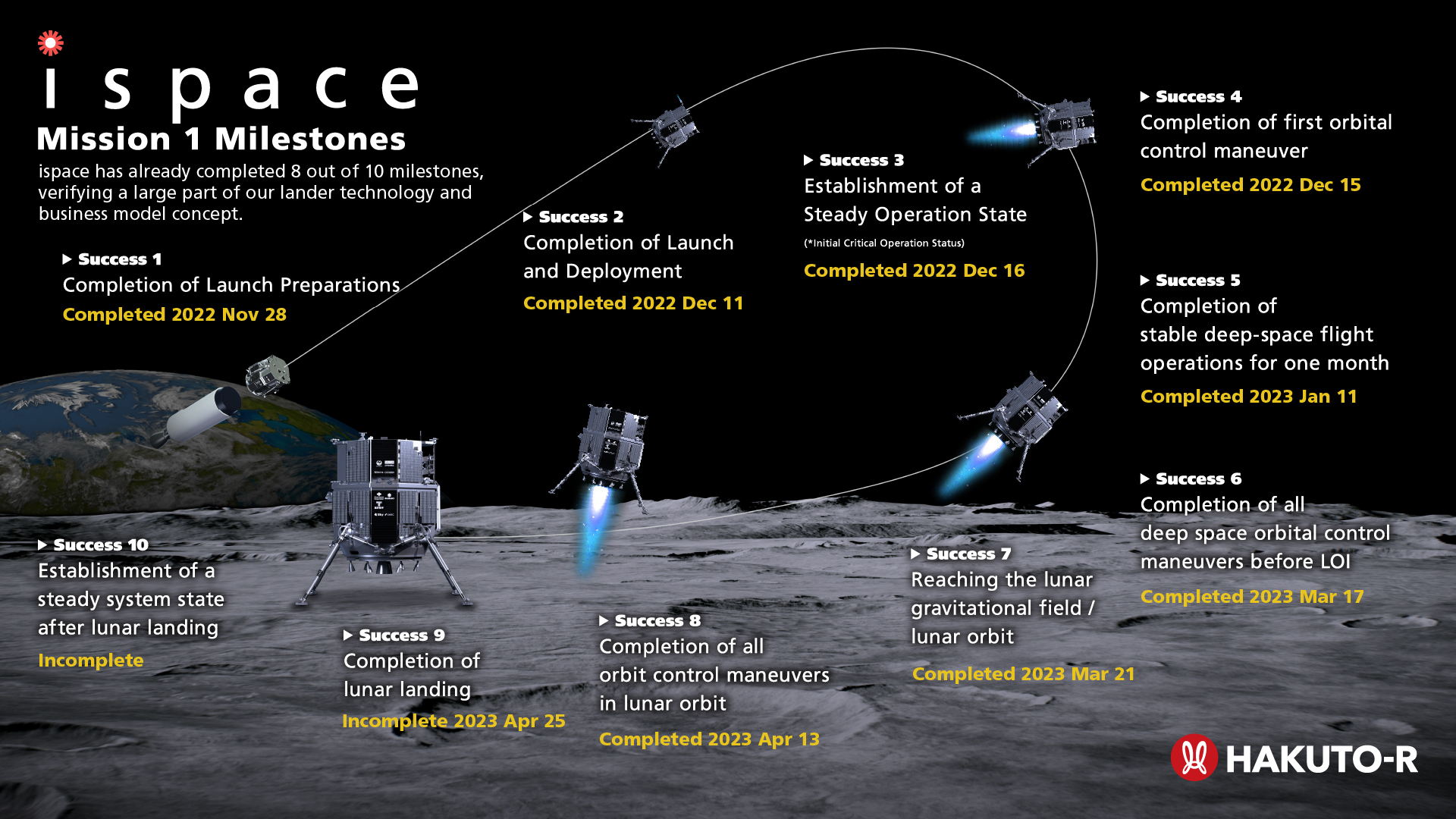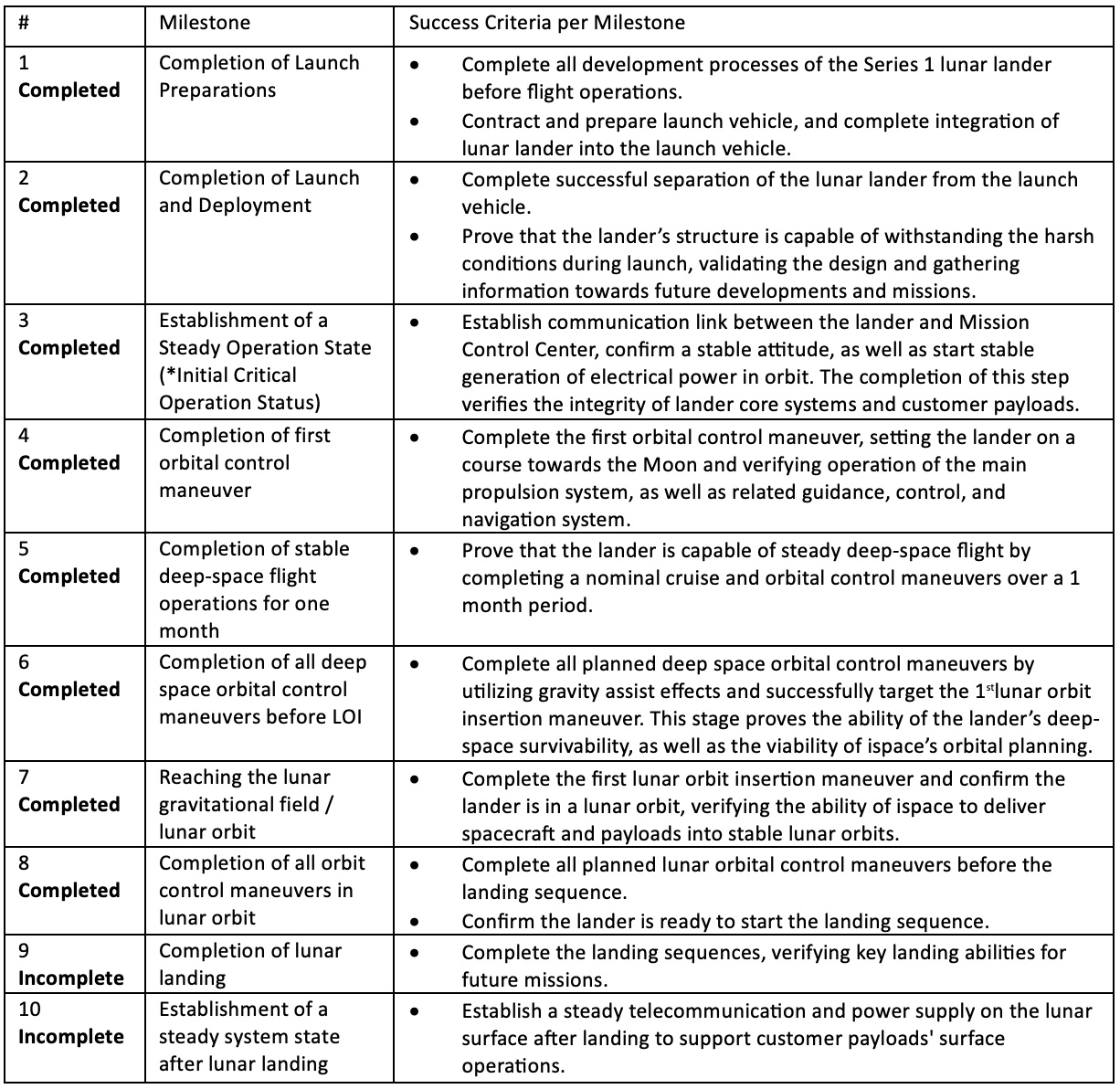26 May, 2023
Landing Anomaly Identified for Future Mission Improvements
TOKYO—May 26, 2023—ispace, inc., (ispace) a global lunar exploration company, announced today that it has reviewed and completed the analysis of the flight data from its HAKUTO-R Mission 1 landing sequence on April 26, 2023. The flight data was obtained by operations specialists at ispace’s Mission Control Center in Nihonbashi, Tokyo.
The analysis reveals that the lander fully completed the entire planned deceleration process, slowing to the target speed of less than 1 m/s in a vertical position at an altitude of approximately 5 kms above the lunar surface. Although the lander did not complete a soft landing, the cause has been identified and improvements are being incorporated into Mission 2 and Mission 3.
On April 26, 2023, at 00:40 Japan Standard Time, the lander began the descent sequence from an altitude of approximately 100 kms above the lunar surface. At the end of the planned landing sequence, it approached the lunar surface at a speed of less than 1 m/s. The operation was confirmed to have been in accordance with expectations until about 1:43 a.m., which was the scheduled landing time.
During the period of descent, an unexpected behavior occurred with the lander’s altitude measurement. While the lander estimated its own altitude to be zero, or on the lunar surface, it was later determined to be at an altitude of approximately 5 kms above the lunar surface. After reaching the scheduled landing time, the lander continued to descend at a low speed until the propulsion system ran out of fuel. At that time, the controlled descent of the lander ceased, and it is believed to have free-fallen to the Moon’s surface.
The most likely reason for the lander’s incorrect altitude estimation was that the software did not perform as expected. Based on the review of the flight data, it was observed that, as the lander was navigating to the planned landing site, the altitude measured by the onboard sensors rose sharply when it passed over a large cliff approximately 3 kms in elevation on the lunar surface, which was determined to be the rim of a crater. According to the analysis of the flight data, a larger-than-expected discrepancy occurred between the measured altitude value and the estimated altitude value set in advance. The onboard software determined in error that the cause of this discrepancy was an abnormal value reported by the sensor, and thereafter the altitude data measured by the sensor was intercepted. This filter function, designed to reject an altitude measurement having a large gap from the lander’s estimation, was included as a robust measure to maintain stable operation of the lander in the event of a hardware issue including an incorrect altitude measurement by the sensor.
One major contributing factor to this design issue was a decision to modify the landing site after critical design review completed in February 2021. This modification influenced the verification and validation plan despite numerous landing simulations carried out before the landing. ispace as the mission operator maintained overall program management responsibility and took into account the modifications in its overall analysis related to completing a successful mission. It was determined that prior simulations of the landing sequence did not adequately incorporate the lunar environment on the navigation route resulting in the software misjudging the lander’s altitude on final approach.
The analysis reveals that the cause of the lander’s failure to make a soft landing was due to the software, especially in the phase just prior to landing. This information will be incorporated into software design, as well as upgrades and expansion of the scope of preparatory simulations of the landing sequence for our future missions, including Mission 2 and Mission 3, to improve the accuracy of landing sequences.
Based on the fact that communications will not be reestablished with the lander, it has been concluded that the completion of the Mission 1 Milestones Success 9 (completion of the lunar landing) and Success 10 (establishment of stable conditions after landing), could not be achieved, and customer payloads could not be operated after the landing.
“Mission 1 demonstrated a great deal of technical reliability, as our lander reached the lunar surface just prior to landing. Now, we have been able to identify the issue during the landing and have a very clear picture of how to improve our future missions. While it is unfortunate that we were not able to fully meet the expectations of all our stakeholders, including our customers, all of us at ispace are proud of what we accomplished in Mission 1 and are very positive about what we can accomplish,” said Takeshi Hakamada, Founder and CEO of ispace. “We have already begun work on Mission 2 and Mission 3. We are prepared to face the challenges and make every effort to improve. We will ensure that the valuable knowledge gained from Mission 1 will lead us to the next stage of evolution. We believe that this is our commitment and our duty to all our stakeholders. ‘Never Quit the Lunar Quest’ In this spirit, we will continue to move forward.”
During Mission 1 the HAKUTO-R lunar lander completed Success 1 through Success 8 of the Mission 1 milestones. The lander was able to withstand the harsh mechanical environment of both the launch and deployment phases without sustaining damage to any of its elements. It then withstood a lengthy deep space cruise demonstrating its flight readiness. In addition, the lander performed well through multiple orbit control maneuvers, indicating that it can be operated in Mission 2 using the same Series 1 model as in Mission 1, without the need for any major modifications. The thermal design, communications, and electric power demonstrated functionality as planned, and based on analysis of the flight data, a more efficient operation can be achieved in Mission 2. At this time, there are no changes to the launch schedule for Mission 2 (scheduled for 2024) and Mission 3 (scheduled for 2025).
Mission 1 Milestones


About ispace, inc.
ispace, a global lunar resource development company with the vision, “Expand our Planet. Expand our Future.”, specializes in designing and building lunar landers and rovers. ispace aims to extend the sphere of human life into space and create a sustainable world by providing high-frequency, low-cost transportation services to the Moon.
The company has offices in Japan, Luxembourg, and the United States with more than 200 employees worldwide. ispace technologies U.S., inc. is part of a team led by Draper, which was awarded a NASA Commercial Lunar Payload Services (CLPS) Program contract to land on the far side of the Moon by 2025 (as of September 2022). Both ispace, and ispace EUROPE S.A. (ispace EU) were awarded contracts to collect and transfer ownership of lunar regolith to NASA, and ispace EU was selected by ESA to be part of the Science Team for PROSPECT, a program which seeks to extract water on the Moon.
Established in 2010, ispace operated “HAKUTO” which was one of five finalist teams in the Google Lunar XPRIZE race. The company’s first mission, part of its HAKUTO-R lunar exploration program, launched on Dec. 11, 2022, from the United States on a SpaceX Falcon 9 rocket and completed 8 of 10 mission milestones. Subsequent missions are in development with launches expected in 2024 and 2025. ispace has also launched a lunar data business concept to support new customers as a gateway to conduct business on the Moon.
For more information, visit: www.ispace-inc.com; Follow us on Twitter: @ispace_inc.